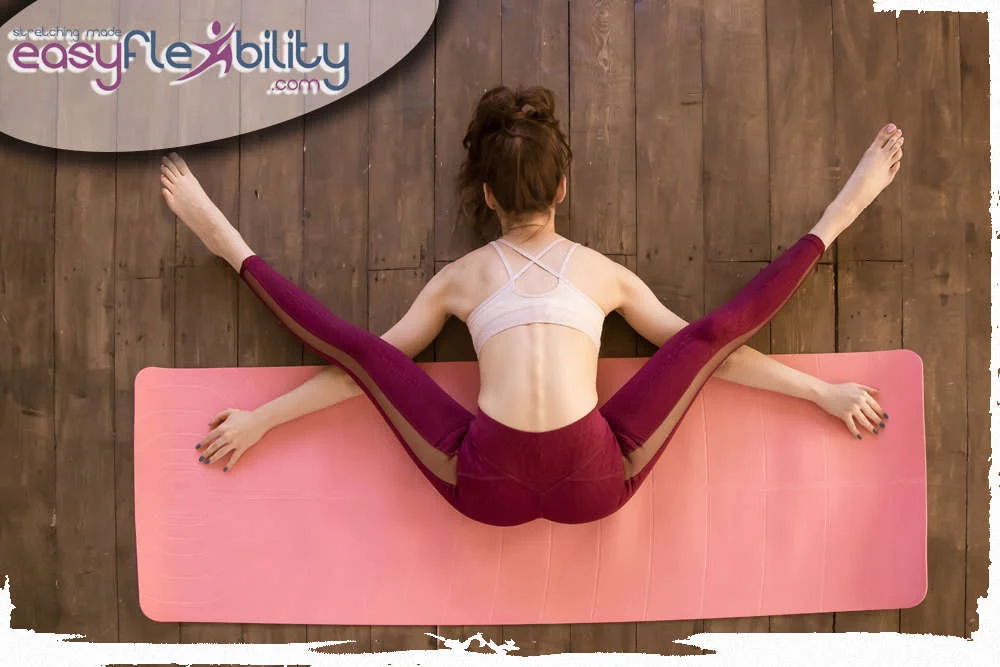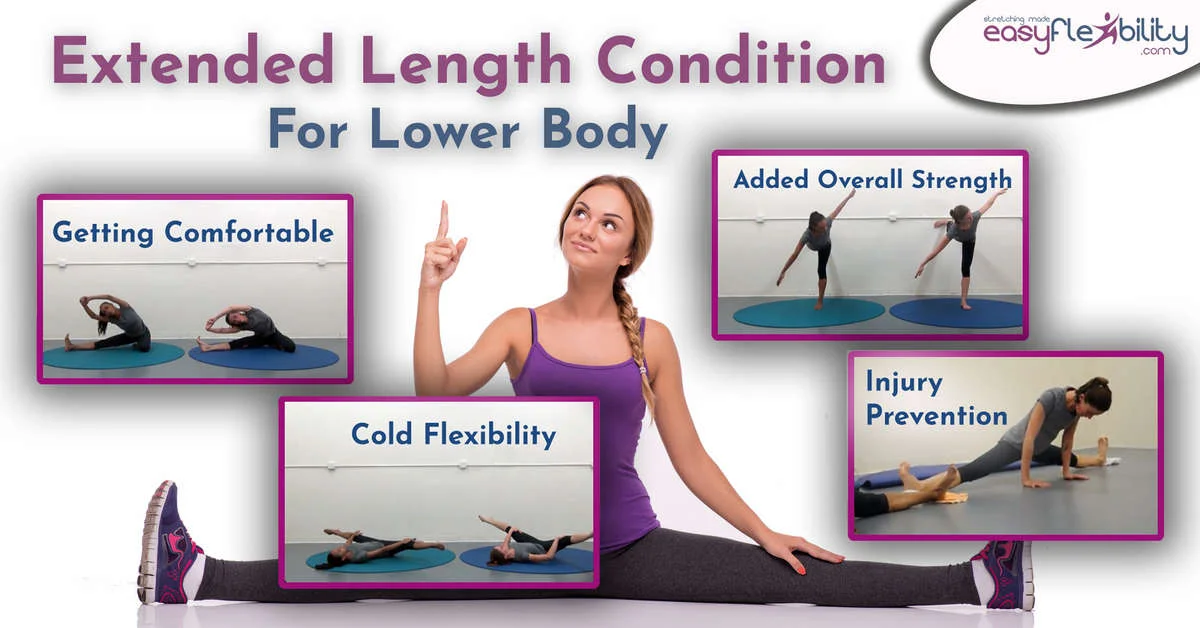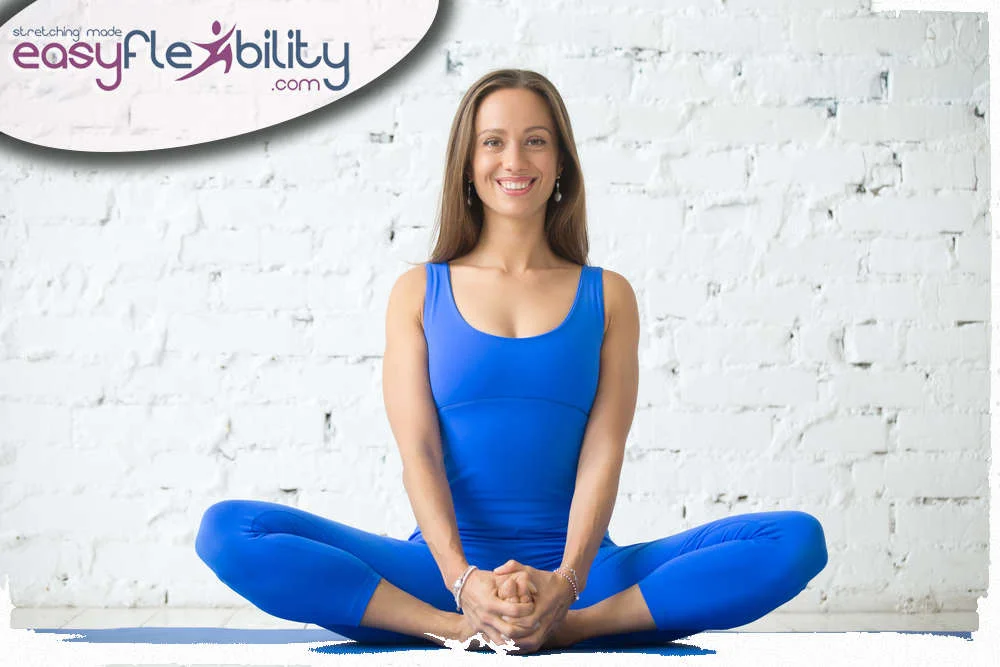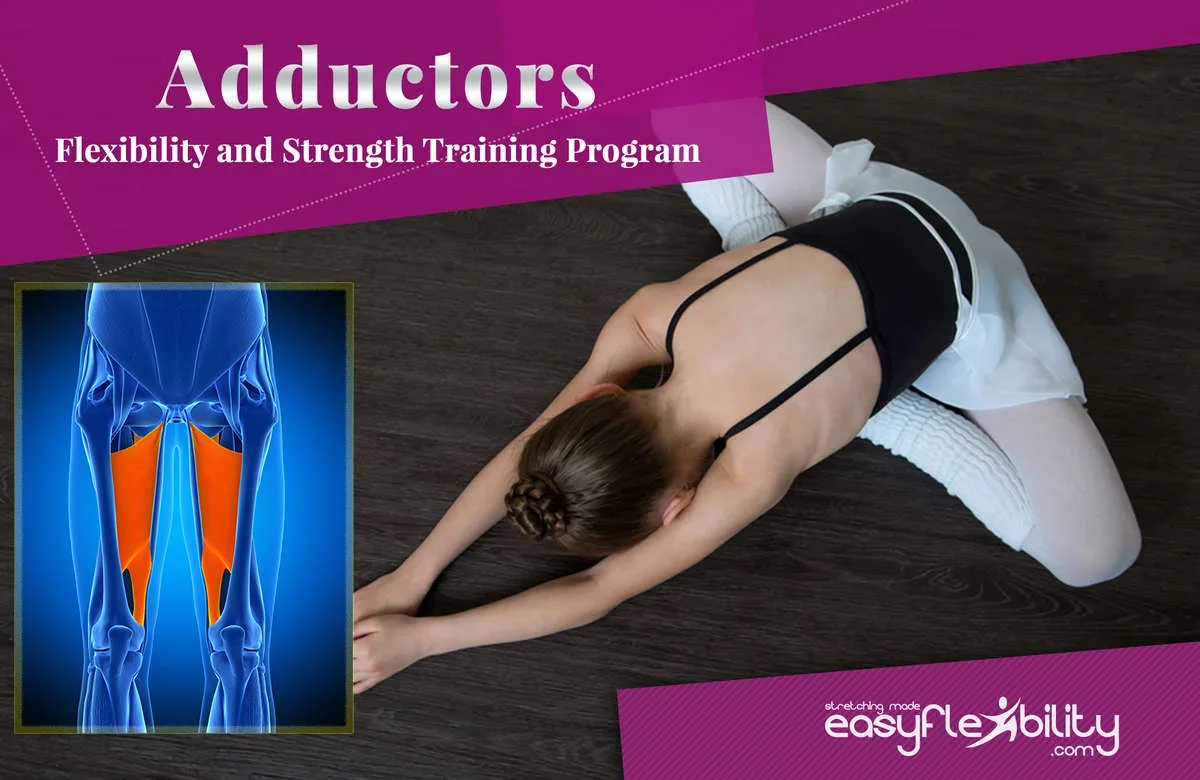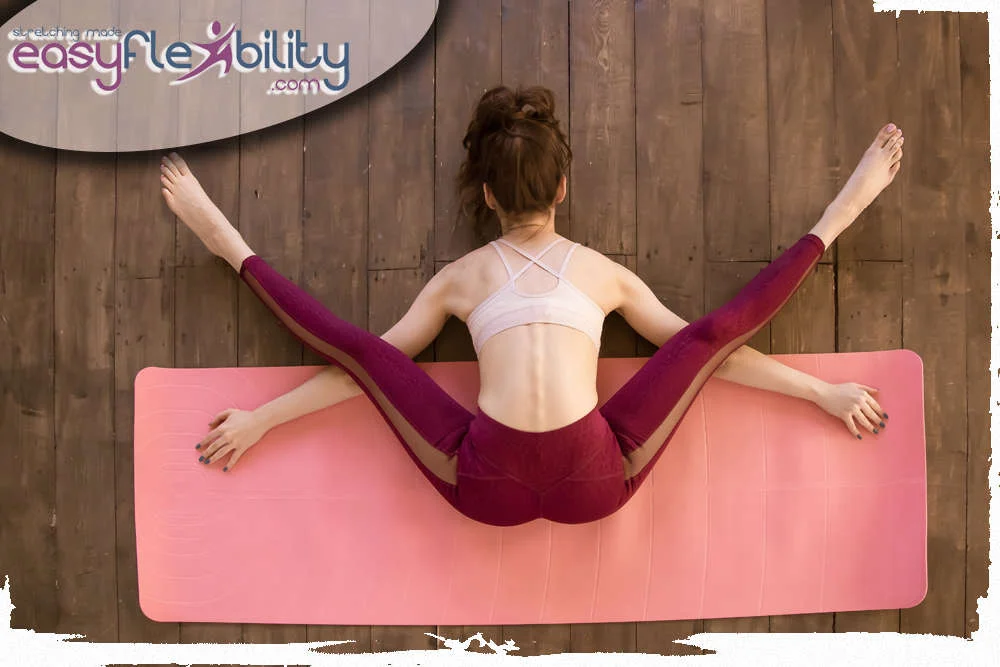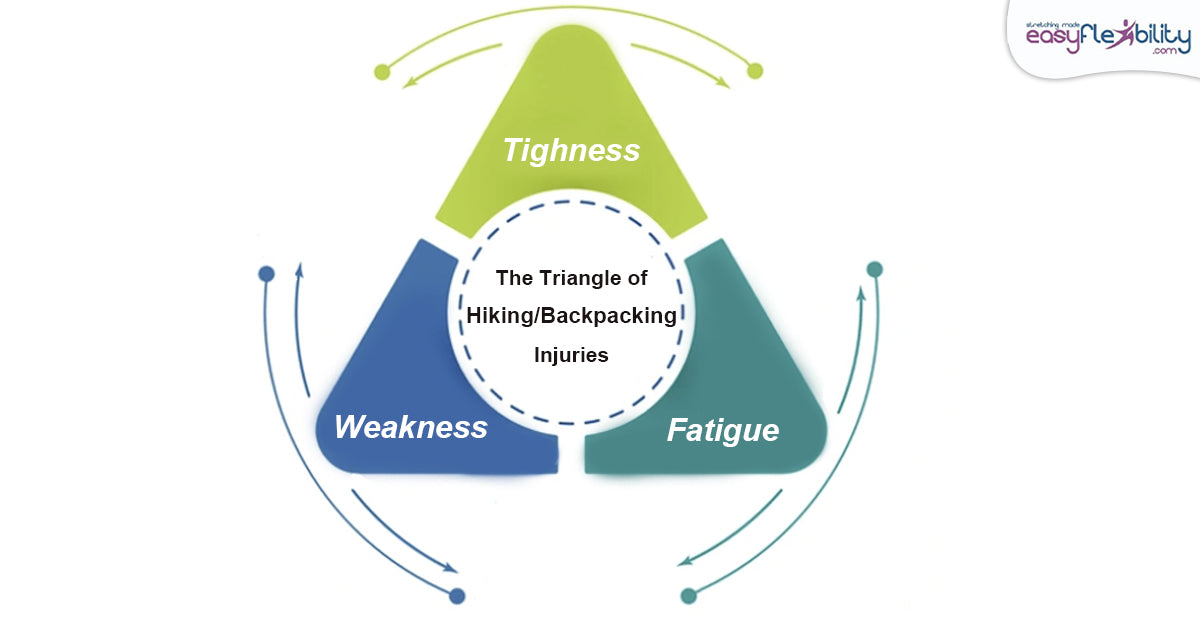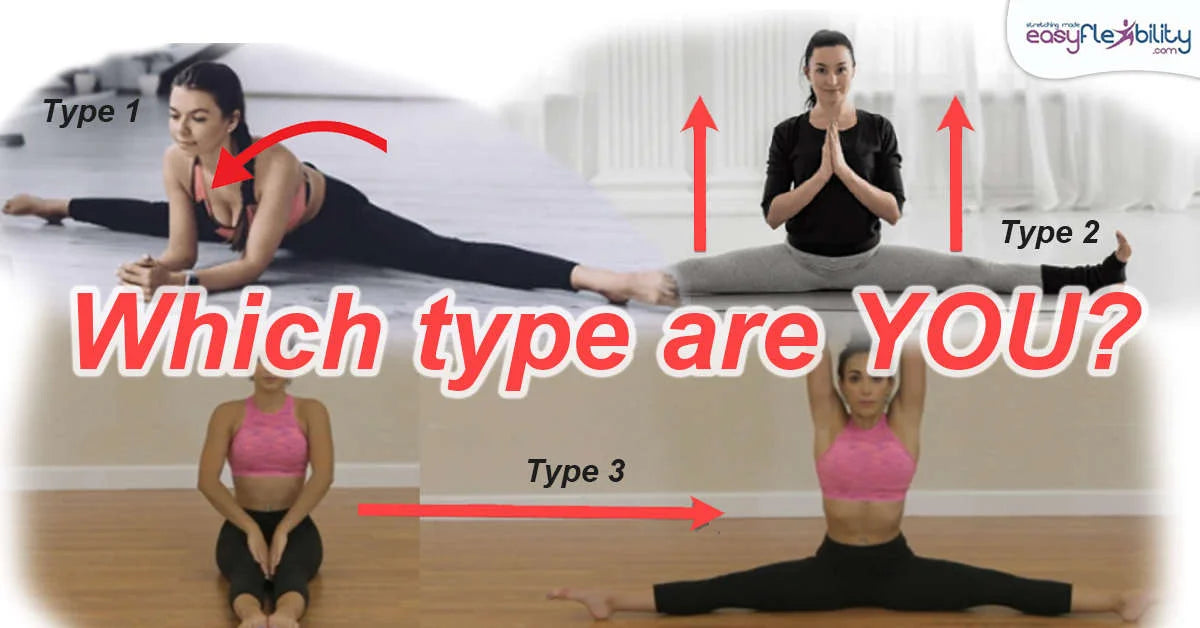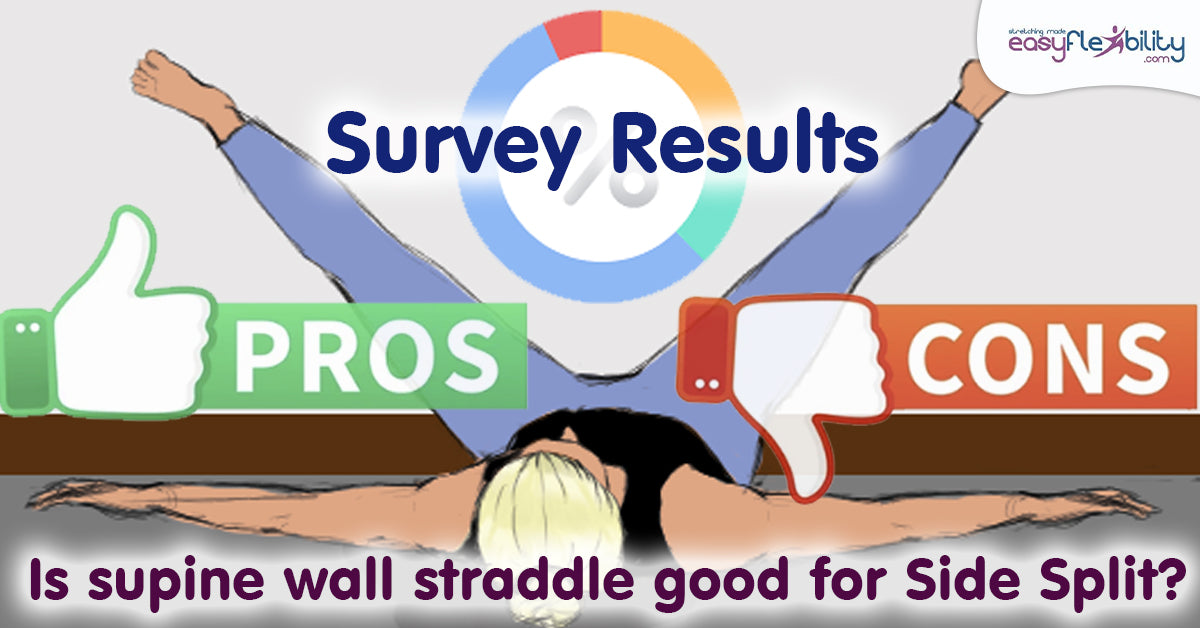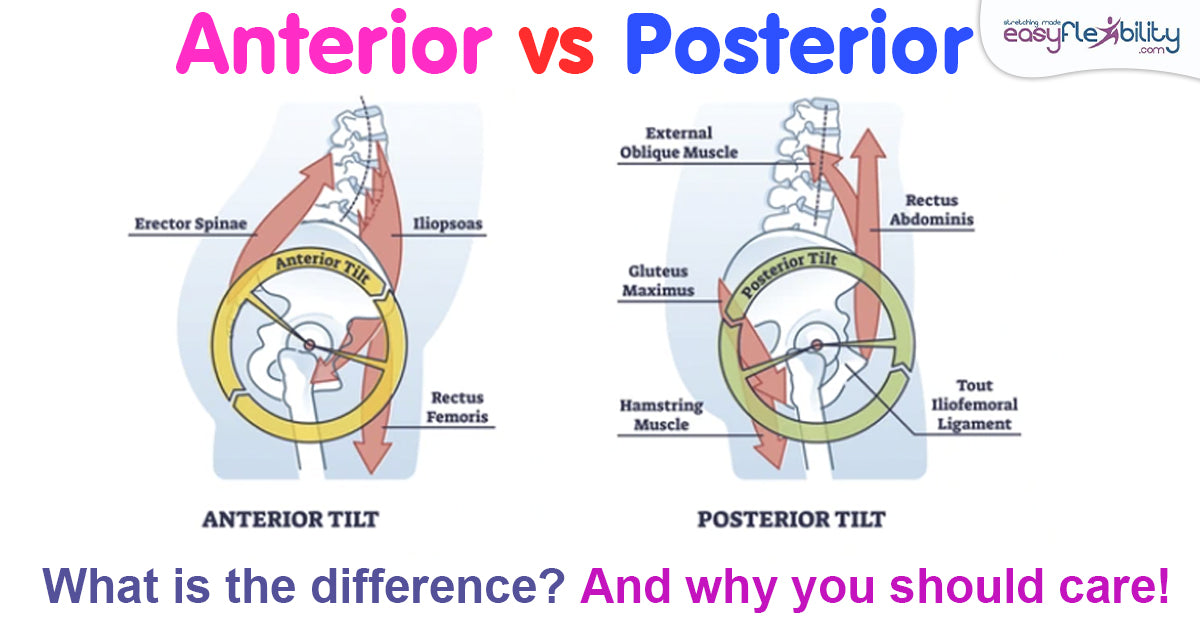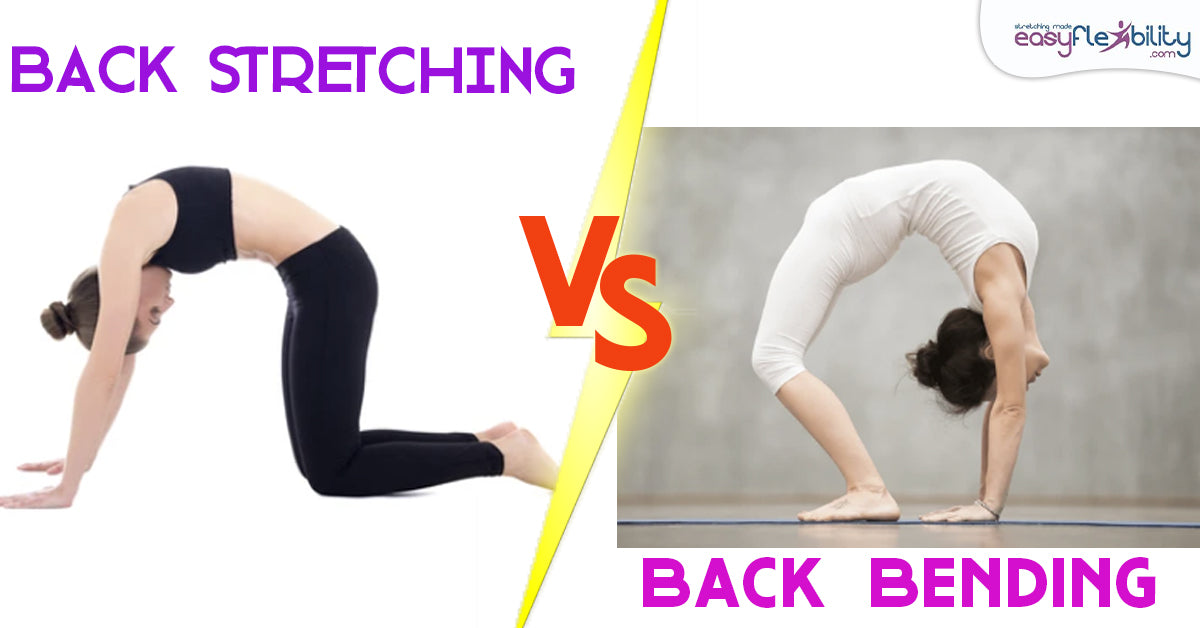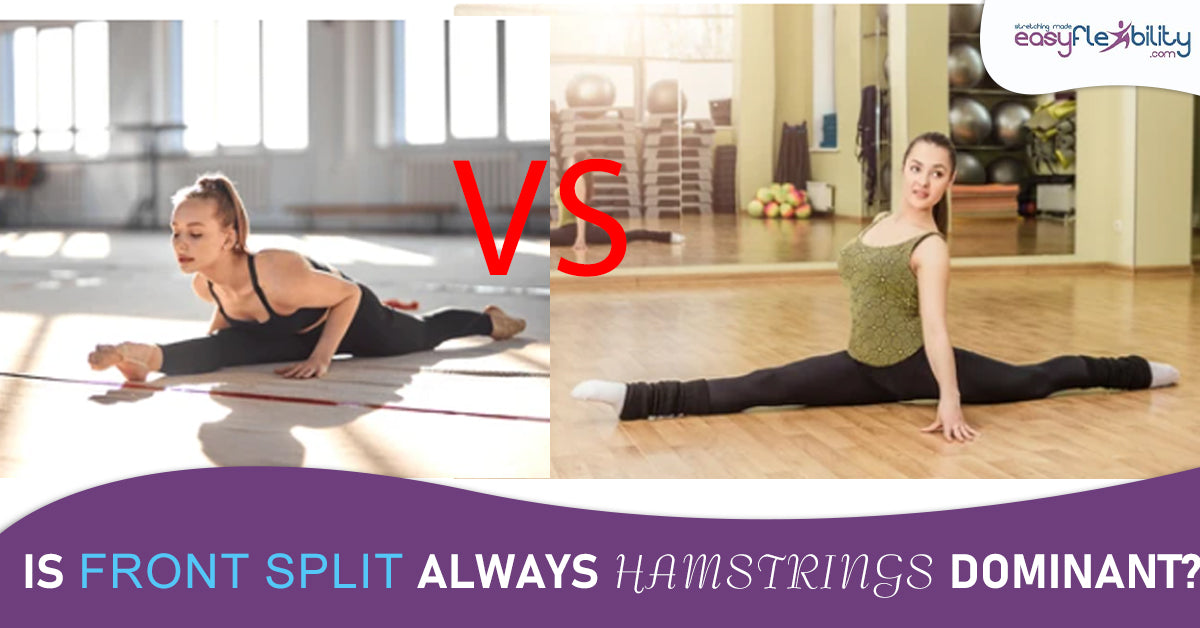Pancake Stretch: Everything you ever wanted to know about this forward bend in straddle position also known as Kurmasana or the Tortoise Pose in Yoga.
Posted by Paul Zaichik on

What is a Pancake Stretch?
A Pancake Stretch is when a person is sitting on the floor with straight legs spread partially apart. The legs are not together as in a full forward bend or double hamstring stretch. The legs are not all the way apart like in a full straddle or full side split. The legs are partially apart, or in Kinesiological terms, the hips are horizontally abducted, but not all the way.
Kinesiology of a Pancake Stretch.
Muscles worked in a Pancake Stretch. Which muscles are being targeted in a Pancake Stretch, depends on how wide the straddle is. The closer together the legs are, the more the hamstrings will be targeted. The wider the legs are apart, the more the abductors will be targeted.
Different teachers from yoga, gymnastics, cheerleading, pole dance and other systems may require the students to have a slightly different degree of horizontal abduction of the leg when doing the Pancake Stretch. However, as soon as you are sitting with your legs in front of you and you begin to move them apart, the Lateral Hamstring begins to shorten.
For most people, when the legs are at 90 degrees apart or more, unless the Lateral Hamstring or the Biceps Femoris is very tight, that muscle will be taken out of the equation. The Medial Hamstrings, on the other hand, the Semitendinosus and Semimembranosus will be stretched regardless how wide the legs are apart. Even if the legs are wide apart, the Medial Hamstrings will still be stretched less so, than if the legs were closer together.
And now the four adductors Adductor Longus, Adductor Magnus, Adductor Brevis and Gracilis will be stretched more the wider apart the legs are. Pectineus, which is sometimes listed with the adductors but is a hip flexor, will come into play when the legs are rather far apart from each other in a Pancake Stretch.
From the joints point of view: When the legs are closer together, the movement is flexion of the hip when a practitioner is attempting to place the chest on the floor. However, the further the legs are apart, the less it is the flexion of the hip and the more it is the external rotation of the hip.
So if someone is in a very wide straddle by placing the torso on the floor, the movement of the hip joint becomes external rotation and thus the medial rotators, which of course are all four adductors, Adductor longus, Magnus Brevis and Gracilis plus Pectineus plus the medial hamstrings will engage a lot more and will have to be stretched a lot more than in a simple straddle that is not a pancake.
Different teachers from yoga, gymnastics, cheerleading, pole dance and other systems may require the students to have a slightly different degree of horizontal abduction of the leg when doing the Pancake Stretch. However, as soon as you are sitting with your legs in front of you and you begin to move them apart, the Lateral Hamstring begins to shorten.
For most people, when the legs are at 90 degrees apart or more, unless the Lateral Hamstring or the Biceps Femoris is very tight, that muscle will be taken out of the equation. The Medial Hamstrings, on the other hand, the Semitendinosus and Semimembranosus will be stretched regardless how wide the legs are apart. Even if the legs are wide apart, the Medial Hamstrings will still be stretched less so, than if the legs were closer together.
And now the four adductors Adductor Longus, Adductor Magnus, Adductor Brevis and Gracilis will be stretched more the wider apart the legs are. Pectineus, which is sometimes listed with the adductors but is a hip flexor, will come into play when the legs are rather far apart from each other in a Pancake Stretch.
From the joints point of view: When the legs are closer together, the movement is flexion of the hip when a practitioner is attempting to place the chest on the floor. However, the further the legs are apart, the less it is the flexion of the hip and the more it is the external rotation of the hip.
So if someone is in a very wide straddle by placing the torso on the floor, the movement of the hip joint becomes external rotation and thus the medial rotators, which of course are all four adductors, Adductor longus, Magnus Brevis and Gracilis plus Pectineus plus the medial hamstrings will engage a lot more and will have to be stretched a lot more than in a simple straddle that is not a pancake.
You can try two exercises from the EasyFlexibility System to help you with your Pancake Stretch right now! The first exercise is called ~Equilibrium~ ZST (Zaichik Stretching Techniques)
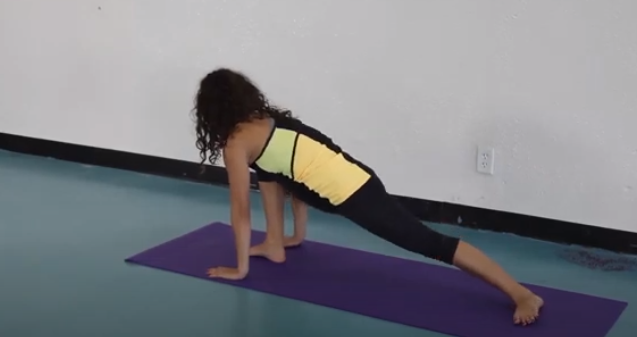
Starting Position:
- Go into a lunge position.
- Place your hands on the floor. Toes forward.
- Keep the chest squared down, do not rotate the chest.

1st Leverage Move:
Do external rotation with the extended leg moving the foot out, without moving the hips.
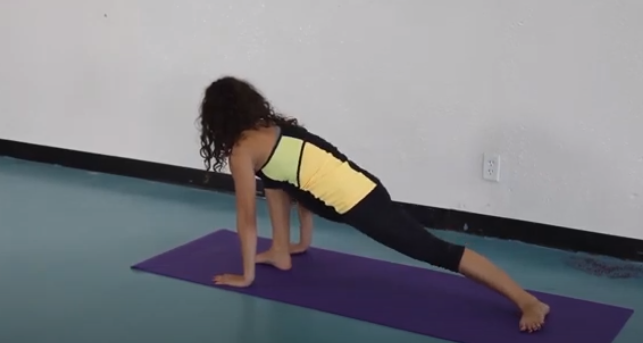
1st Target Move:
Drop the foot and come down the body moving hips into the floor.
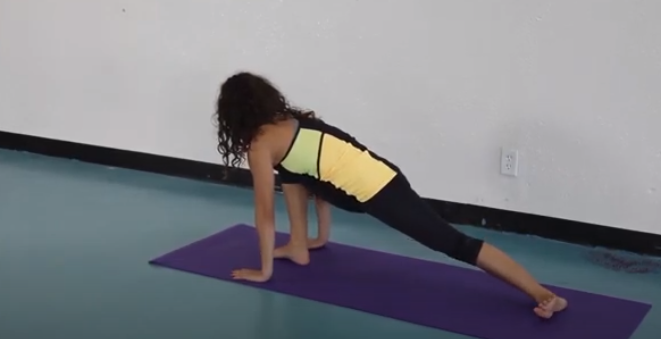
2nd Leverage Move:
Do external rotation with the extended leg moving the foot out, without moving the hips.
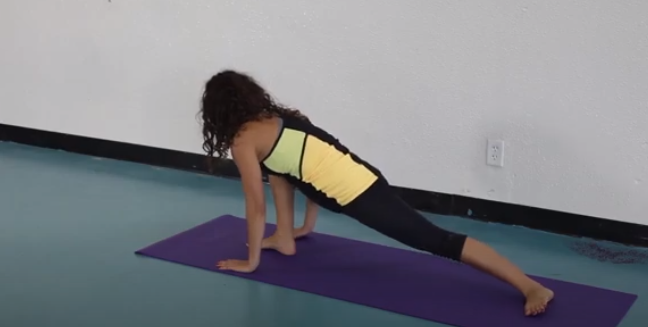
2nd Target Move:
Come down the body and move hips deeper into the floor.
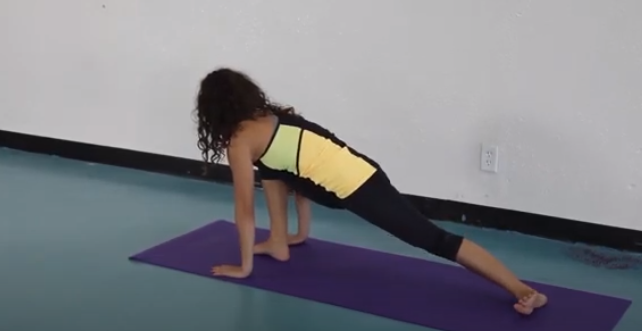
3rd Leverage Move:
Do external rotation with the extended leg moving the foot out, without moving the hips.
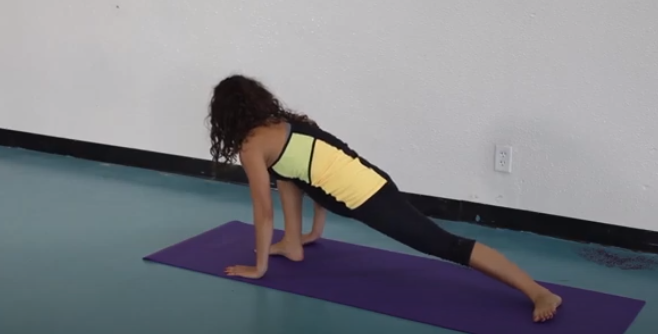
3rd Target Move:
Come down the body and move hips deeper into the floor.
The Second exercise is ~Peace~ ZST to help with your Hamstrings:
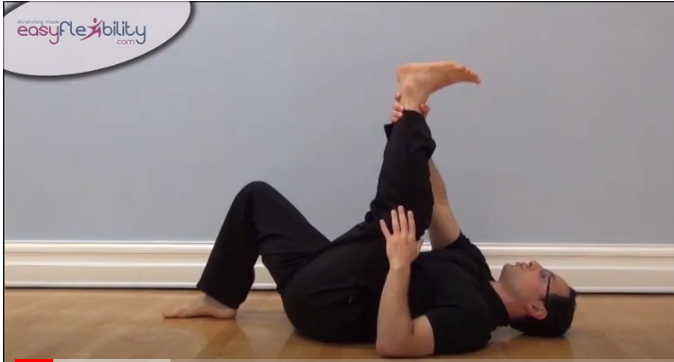
Starting Position
- Lie down on the floor.
- Pull the right knee in, extend the knee. Make sure the hip is flex enough that the knee is not straight.
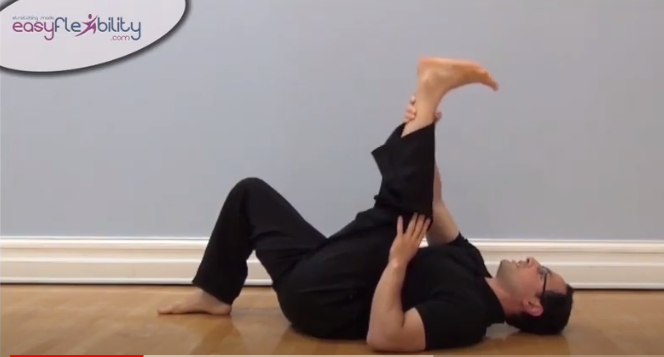
1st Leverage move:
Pull the knee extended without getting into the point that the knee is completely extend. This would look like a foot kick with the ball of the foot.
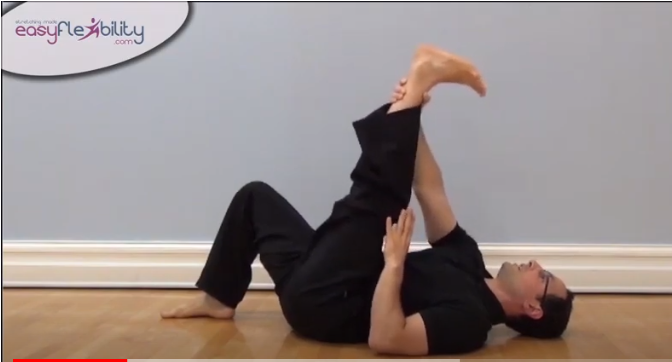
1st Target move:
Try to extend the knee straight. This would look like a kick with the heel.
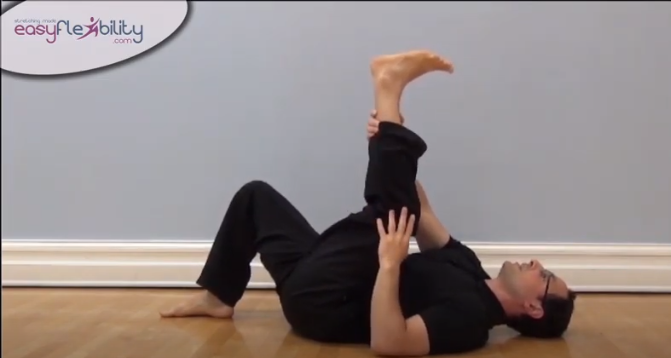
2nd Leverage move:
Pull the knee extended without getting into the point that the knee is completely extend.
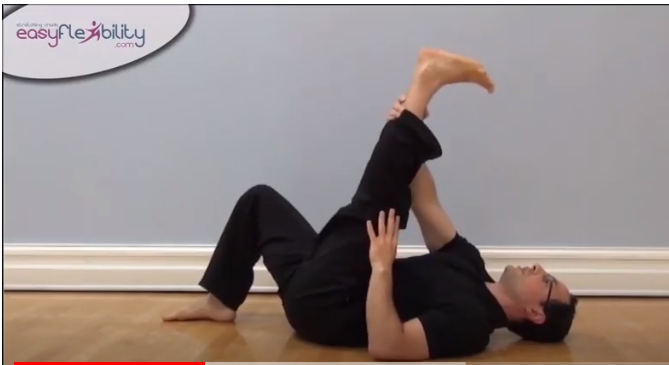
2nd Target move:
Extend the knee straight.
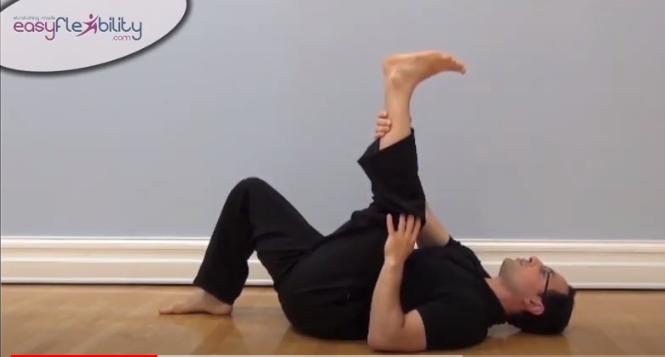
3rd Leverage:
Pull the knee extended without getting into the point that the knee is completely extend.
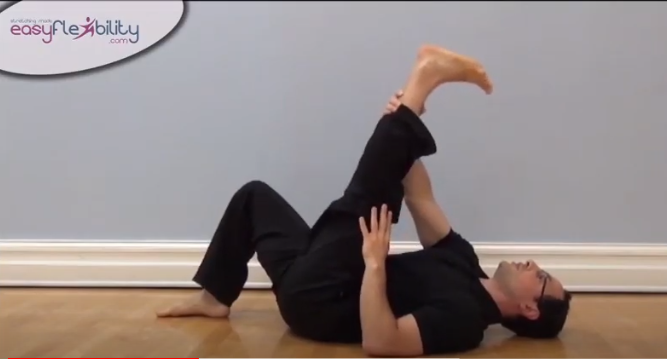
3rd Target Move:
Extend the knee straight
Pancake Stretch with legs closer together or Pancake Stretch with legs further apart. Which one is easier?
In my experience, majority of people will have more tightness in their Lateral Hamstrings than they would in the adductors. There are exceptions, of course. So based on this a straddle with the legs wider apart is generally easier.
Why am I bending my back in a straddle and how can I prevent my back from bending when I do a Pancake Stretch?
You're bending your back because when you stretch a chain, the weakest link gives. Usually, people have flexibility in their spine much more than compared to the flexibility in their hips. Thus, by simply trying to reach forward, the least tightest part of your body will give. Which is the muscles of the back, causing your back to round.
There are simply too many strong, tight muscles to stretch at the same time. A solution to this issue is to train with the EasyFlexibility programs, where we stretch each muscle one at a time rather than all muscles together. It's a lot easier to do. The stretch can be seen in real time. And once you stretch each muscle, one at a time using ZST's or Zaichik Stretching Techniques, you can try the Pancake Stretch again and you'll see the results as opposed to simply sitting there and trying to reach your arms or your body forward.
There are simply too many strong, tight muscles to stretch at the same time. A solution to this issue is to train with the EasyFlexibility programs, where we stretch each muscle one at a time rather than all muscles together. It's a lot easier to do. The stretch can be seen in real time. And once you stretch each muscle, one at a time using ZST's or Zaichik Stretching Techniques, you can try the Pancake Stretch again and you'll see the results as opposed to simply sitting there and trying to reach your arms or your body forward.
Kurmasana, Tortoise Pose, Pancake Stretch Program
Kurmasana is also called the Tortoise Pose or the Pancake Stretch. This pose is also a gate way to more advanced yoga poses and hand balances.
Our program is unique. The pose is quickly broken up into it's components. Each is targeted quickly with Zaichik Stretching techniques. Principles of creating space in the same muscles through multiple actions is used. This allows for quick flexibility development, while avoiding the stretch reflex. The progress comes much faster, than with standard yoga techniques.
How come my Pancake Stretch progress doesn't stick after I'm done doing the stretching?
If all you do is stretching exercises, get a little bit more flexible and then stop, and try to repeat the same thing during your next training session, you are giving your body a signal that it should get more flexible after some stretching. But that is not enough. To keep your flexibility, you have to show your body that this flexibility is useful and is safe to do. Strength exercises and movement exercises are incorporated together with stretching exercises into your Pancake Stretch.
So the supporting exercises or the retention exercises for the Pancake Stretch will depend on individual level of flexibility. For example, someone who is not flexible, who might attempt to do the Extended Length Conditioning Exercises by sitting in a straddle and bowing the body forward and up is not going to get much benefit. To do that, one may need to either sit on a prop like a yoga block or two, or to do a deadlift in a standing position with legs wide apart. And for beginner, possibly even with knees slightly bent.
There are many types of supportive retention exercises and Extended Length Conditioning is just one type. Depending on the athlete's need, different types can be used
So the supporting exercises or the retention exercises for the Pancake Stretch will depend on individual level of flexibility. For example, someone who is not flexible, who might attempt to do the Extended Length Conditioning Exercises by sitting in a straddle and bowing the body forward and up is not going to get much benefit. To do that, one may need to either sit on a prop like a yoga block or two, or to do a deadlift in a standing position with legs wide apart. And for beginner, possibly even with knees slightly bent.
There are many types of supportive retention exercises and Extended Length Conditioning is just one type. Depending on the athlete's need, different types can be used
Extended Length Conditioning for Lower Body Program
Extended Length Conditioning are a special exercise group.
Unlike regular strength exercises, which work in the normal range, ELC connect the "normal" with the "new", deep range.
Unlike regular strength exercises, which work in the normal range, ELC connect the "normal" with the "new", deep range.
Extended Length Conditioning exercises have helped many people to stay safe, maintain their flexibility gains, and develop flexibility faster than before. Sometimes even one session is enough to see the results of these techniques.
And of course, supporting exercises should also emphasize the goal of the Pancake Stretch. For example, if someone is going to be doing a jump then the muscles that lift the legs, the hip flexors and the adductors should be trained. Yes, it is a paradox that adductors are stretched, but adductors also lift the legs, helping the hip flexors. So, these muscles should be trained over the extended length conditioning or trained by themselves independently.
Should I master a full side split or a full straddle first before working on a Pancake Stretch?
The wide pancake and the side split work the same muscles since your adductors are also your medial rotators and so is the medial hamstring. This means that a wide straddle will help your Pancake Stretch, as well as your Pancake Stretch will help to improve your straddle.
Pancake Stretching routine for beginners.
If you are a beginner who is new to flexibility training and you want to work on your Pancake Stretch, I strongly recommend some level of strength conditioning. Most people just want to get into a Pancake Stretch and just get to their goal. But a basic conditioning program done two to three times a week, even for three or four weeks, will greatly speed up the process.
Just like sharpening an axe will speed up the rate of chopping down the wood as opposed to simply grabbing an axe and trying to chop down the wood without preparing it first. Conditioning exercises recommended would be lunges, wide squats or sumo squats, wide leg stiff leg deadlift. And for very beginners, this should be performed with bent knees, leg circles in supine position and leg circles lying down on a side position. Each can be performed for 2 to 3 sets of 10 to 15 repetitions each.
Just like sharpening an axe will speed up the rate of chopping down the wood as opposed to simply grabbing an axe and trying to chop down the wood without preparing it first. Conditioning exercises recommended would be lunges, wide squats or sumo squats, wide leg stiff leg deadlift. And for very beginners, this should be performed with bent knees, leg circles in supine position and leg circles lying down on a side position. Each can be performed for 2 to 3 sets of 10 to 15 repetitions each.
Will Butterfly Stretch help with a Pancake Stretch?
Butterfly Stretch targets the short adductors; adductor longus, brevis, Magnus. It also targets the Pectineus, but because of the bent knee, it's not a good exercise for Gracilis. At the same time, the hamstrings are not targeted for the same reason, the knee is bent. So performing the butterfly stretch will partially help with some of the muscles, but it will not help with all of them.
If you're able to do a butterfly but you cannot do a Pancake Stretch, you can simply use the Zaichik Stretching Techniques for the other muscles not being targeted in a butterfly. Since Zaichik Stretching Techniques isolate each muscle one at a time, you should be able to get your Pancake Stretch pretty quickly.
If you're able to do a butterfly but you cannot do a Pancake Stretch, you can simply use the Zaichik Stretching Techniques for the other muscles not being targeted in a butterfly. Since Zaichik Stretching Techniques isolate each muscle one at a time, you should be able to get your Pancake Stretch pretty quickly.
The Butterfly Stretch
In this program you will learn everything that you need in order to get your butterfly stretch! If you can touch your toes this is the Program for you! This is a full follow along workout for fast butterfly stretch flexibility.
How come I can do a full forward bend with my legs together but not a full Pancake Stretch?
If this is the case with you, you my friend are in a special category. As mentioned above, there are people who have flexible hamstrings and yet tight adductors. So, you would then focus on your adductors.
You may need a little bit more flexibility than you have in your medial hamstring, or you may not. However, your Adductor magnus longus, both Gracilis and Pectineus would need work. And again, you can use ZST's or Zaichik Stretching Techniques to target those. Isolate them and you will be on your way to a full Pancake Stretch very quickly because you already have part of the component needed.
You may need a little bit more flexibility than you have in your medial hamstring, or you may not. However, your Adductor magnus longus, both Gracilis and Pectineus would need work. And again, you can use ZST's or Zaichik Stretching Techniques to target those. Isolate them and you will be on your way to a full Pancake Stretch very quickly because you already have part of the component needed.
Adductors Strength & Flexibility
Online On-Demand Flexibility & Strength Training Program
This Adductors program will help you to improve your adductors strength and flexibility, safely, painlessly and quickly with the use of the Proprietary Zaichik Stretching Techniques and Supporting Exercises.
How come I can do a Pancake Stretch on the floor but when I try to do it on a bar in gymnastics, I'm not able to do it properly?
So the same question would apply to people who practice Pole Dance and are trying to do setups as a pancake on a pole. There are two components to this answer. One is active flexibility and passive flexibility are not the same thing. So, you would need to strengthen the muscles that lift the legs up in short ranges. They may be perfectly strong in normal ranges, but in short ranges, which is where your torso is between your legs, in these ranges they might be pretty weak. And so, you will need to strengthen them.
The other factor is having more flexibility than needed. Having more flexibility than needed for the skill always allows the body to save some struggle on the strength component. In other words, towards the end of your range, the body begins to resist passively or perhaps with the assistance of a partner or assistance of gravity when you properly position yourself for gravity to help you, you can go deeper than you can without that assistance. So, if you had more flexibility, you would get less resistance from your muscles.
The other factor is having more flexibility than needed. Having more flexibility than needed for the skill always allows the body to save some struggle on the strength component. In other words, towards the end of your range, the body begins to resist passively or perhaps with the assistance of a partner or assistance of gravity when you properly position yourself for gravity to help you, you can go deeper than you can without that assistance. So, if you had more flexibility, you would get less resistance from your muscles.
Should I practice a Pancake Stretch with my toes pointed or my toes pulled back?
Ideally, you would practice the same way as you will be using the skill. So, if you are going to perform a Pancake Stretch, for example in transition on the high bar with your toes pulled back. Then you should practice with your toes pulled back. If you're going to use it in a jump with your toes pointed, then practice with toes pointed.
You'll notice that the stretch is more difficult with your toes pulled up simply because there is a pull through the fascia and there's more stretch on the sciatic nerve than when the toes are pointed. You may also notice that when your toes are pointed, your sides are even, left and right, but once you pull your toes back, one side becomes tighter than the other. This can happen because of an issue with a sciatic nerve on one side and not the other.
And finally, even if you do practice this technique with the toes pointed, it's still good to practice the pancakes stretch with toes pulled back toward you, otherwise known as a Dorsi Flex position, because this will give you an extra stretch when you need it.
You'll notice that the stretch is more difficult with your toes pulled up simply because there is a pull through the fascia and there's more stretch on the sciatic nerve than when the toes are pointed. You may also notice that when your toes are pointed, your sides are even, left and right, but once you pull your toes back, one side becomes tighter than the other. This can happen because of an issue with a sciatic nerve on one side and not the other.
And finally, even if you do practice this technique with the toes pointed, it's still good to practice the pancakes stretch with toes pulled back toward you, otherwise known as a Dorsi Flex position, because this will give you an extra stretch when you need it.
How come the muscles in my legs spasm when I try to do the Pancake Stretch in certain positions?
The reason that your muscles spasm when you try to do the Pancake Stretch is because you are contracting your muscles in the short ranges. To understand the short range: If you were to flex your elbow and touch your thumb to your shoulder and try to squeeze your bicep in that position, this is a short range. If your elbow is at 90 degrees, that is a medium range. And if your elbow is straight and you are contracting a bicep with your elbow straight, that is the long range for the bicep.
All muscles are comfortable in contracting in the middle ranges and their short ranges. In their long ranges this is when they are the weakest and also the most vulnerable. If you never had the flexibility to do a Pancake Stretch and now you do, this means that your muscles were never in those ranges before. And now they are contracting for the first time, so spasms and cramps are a normal occurrence. It is recommended to use lighter resistance by using assistance or by gradually tensing the muscle to work in the short ranges, by starting from the mid-range and working toward the short range.
All muscles are comfortable in contracting in the middle ranges and their short ranges. In their long ranges this is when they are the weakest and also the most vulnerable. If you never had the flexibility to do a Pancake Stretch and now you do, this means that your muscles were never in those ranges before. And now they are contracting for the first time, so spasms and cramps are a normal occurrence. It is recommended to use lighter resistance by using assistance or by gradually tensing the muscle to work in the short ranges, by starting from the mid-range and working toward the short range.
I can only place my head on the floor in a Pancake Stretch. Is it an attainable goal to place my abdomen on the floor in the pancakes stretch?
I know people who have been stuck in this position for years. Some are only able to place their head on the floor because they bend their spine almost in half. However, it is very possible to bend forward and place the body on the floor. It takes work, it takes proper training, but it is very possible.
If you have been struggling for a long time and what you're doing is not working, it's time to try something new. We recommend giving EasyFlexibility Pancake Stretch Program a chance. It will definitely be different than anything you have tried before, and you could judge its results for yourself in 3 to 4 weeks. You might even start seeing results sooner than that.
If you have been struggling for a long time and what you're doing is not working, it's time to try something new. We recommend giving EasyFlexibility Pancake Stretch Program a chance. It will definitely be different than anything you have tried before, and you could judge its results for yourself in 3 to 4 weeks. You might even start seeing results sooner than that.
Kurmasana, Tortoise Pose, Pancake Stretch Program
Kurmasana is also called the Tortoise Pose or the Pancake Stretch. This pose is also a gate way to more advanced yoga poses and hand balances.
Our program is unique. The pose is quickly broken up into it's components. Each is targeted quickly with Zaichik Stretching techniques. Principles of creating space in the same muscles through multiple actions is used. This allows for quick flexibility development, while avoiding the stretch reflex. The progress comes much faster, than with standard yoga techniques.
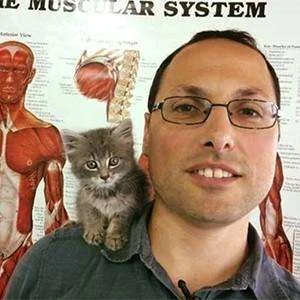
About the Author:
Paul Zaichik is an Exercise Science Expert, author of multitude of books, and the creator of Zaichik Stretching Technique (formely known as Kinesiological Stretching Technique). His speciality is flexibility training as well as body weight conditioning. His innovative method is designed to have maximum carry over into specific athletic techniques. Paul is the author of books and DVD’s on the topic of flexibility, martial arts and bodyweight training. Over the years, Paul Zaichik has worked with a variety of individuals including athletes, entertainers, and military personnel. His ElasticSteel Method of Athletic Conditioning programs, EasyFlexibility Programs and Zaichik Stretching Techniques are used world wide by both professional and amateurs with great success.
© ElasticSteel Corp., EasyFlexibility, Paul Zaichik, et. El., 2022. No part of the materials available through ElasticSteel.com, EasyFlexiiblity.com, site may be copied, photocopied, reproduced, translated or reduced to any electronic medium or machine-readable form, in whole or in part, without prior written consent of Paul Zaichik EasyFlexibility.com, Elasticsteel.com.. Any other reproduction in any form without the permission of Paul Zaichik EasyFlexibility.com, Elasticsteel.com is prohibited. All materials contained on this site are protected by United States copyright law and may not be reproduced, distributed, transmitted, displayed, published or broadcast without the prior written permission of Paul Zaichik, EasyFlexibility.com, Elasticsteel.com.
Share this post
- 0 comment
- Tags: easyflexibility, flexibility, how to get flexible fast, kinesiological stretch, pancake Stretch, stretch, stretching, tortoise, Training Flexibility, Yoga, yoga for stretch and flexibility
0 comment

